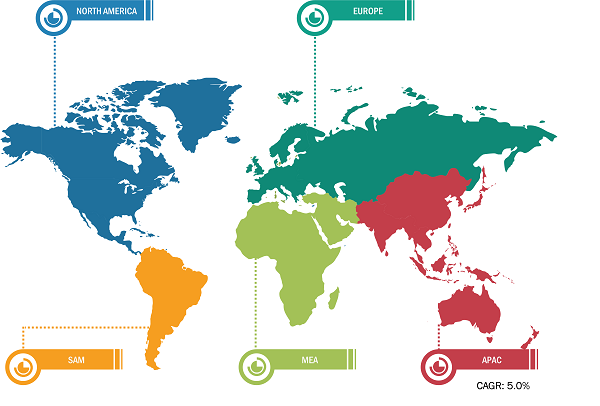Surging Number of Health-Conscious Consumers Fuel Frozen Fruits Market Growth
According to our latest market study on "Frozen Fruits Market Size and Forecast (2021–2031), Global and Regional Share, Trend, and Growth Opportunity Analysis – by Type, Category, and End Use," the frozen fruits market share was valued at US$ 35.15 billion in 2024 and is anticipated to reach US$ 47.74 billion by 2031; it is estimated to register a CAGR of 4.5% during 2025–2031. The report includes prospects regarding the current frozen fruits market analysis and driving factors propelling the market.
The surging number of health-conscious consumers globally drives the frozen fruits market share. AFFI research indicates that over 80% of US consumers acknowledge that frozen fruits are a healthy and convenient option. Consumers' rising focus on health and wellness has influenced the demand for frozen fruits. These frozen fruits are in high demand in the food processing industry as consumers increasingly shift toward healthier alternatives, such as fruit smoothies, desserts, sauces, fruit-based beverages, and baked goods.
Frozen Fruits Market Growth – by Region
Frozen Fruits Market Size and Forecast (2021 - 2031), Global and Regional Share, Trend, and Growth Opportunity Analysis Report Coverage: By Type (Citrus Fruits [Orange, Lemon, Lime, Grapefruit, and Others], Berries [Elderberry, Currants, Strawberry, Raspberry, Blueberry, Blackberry, and Others], Tropical Fruits [Mango, Pineapple, Papaya, Banana, Passion Fruit, Coconut, and Others], Pome Fruits [Apple, Pear, and Others], Stone Fruits [Peaches and Nectarines, Apricots, and Others], Others); Category (Organic, Conventional); End Use (Food Processing [Bakery and Confectionery, Dairy and Frozen Desserts, Beverage, Baby Food, and Others], Food Retail [Supermarkets and Hypermarkets, Convenience Stores, Online Retail, and Others], Foodservice [Quick-Service Restaurants, Full-Service Restaurants, Cafes and Bars, and Others]) and Geography
Frozen Fruits Market Size, Share & Growth Forecast 2031
Download Free Sample
The frozen fruits market trends include the booming e-commerce sector, which has made products more visible and convenient to consumers in the retail industry. According to the American Frozen Food Institute, the retail channel is penetrated with more than 94% of American households buying frozen fruit and vegetables. Organized retail has contributed to the demand for frozen fruit in Europe, with Germany and the UK recording household penetration rates of more than 85%. This retail growth was enhanced by private-label offerings that offer cost-effective solutions and increased sales volume. Quick-service restaurants and upscale cafés use frozen fruits to ensure year-round availability, maintain product consistency, and enhance operational efficiency. The National Restaurant Association in the US has consistently reported that fruit inclusions are a top menu trend, with over 76% of consumers expressing a desire for more fruit options. This requirement translates to large-scale purchases of frozen fruit that can be used in making smoothies, desserts, bakery fillings, and breakfast items. According to the USDA, the market value of US imports of frozen strawberries, one of the significant foodservice ingredients, is more than US$ 300 million per year. The synergy between these expanding channels supports steady B2B and B2C development, enforcing the market's sustainable growth trajectory.
The report includes the segmentation of the global frozen fruits market as follows:
The frozen fruits market has been segmented into type, category, and end use. Based on type, the global frozen fruits market is classified into citrus fruits, berries, tropical fruits, pome fruits, stone fruits, and others. The citrus fruits segment is categorized into orange, lemon, lime, grapefruit, and others. The berries segment is divided into strawberries, raspberries, blueberries, blackberries, elderberries, currants, and others. The tropical fruits segment is categorized into mango, pineapple, papaya, banana, passion fruit, coconut, and others. The pome fruit segment is divided into apple, pear, and others. The stone fruits segment is categorized into peaches, nectarines, apricots, and others. The tropical fruits segment accounted for the largest market share in 2024. These fruits' vibrant colors and natural sweet flavors make them an appealing choice for products, smoothies, desserts, and beverages.
Based on category, the frozen fruits market is bifurcated into organic and conventional. The conventional segment accounted for the largest market share.
On the basis of end use, the market is segmented into food processing, food retail, and foodservice. The food processing segment is categorized into bakery and confectionery, dairy and frozen desserts, beverages, baby food, and others. The food retail segment is divided into supermarkets and hypermarkets, convenience stores, online retail, and others. The foodservice segment is classified into full-service restaurants, quick-service restaurants, cafés and bars, and others. The food processing segment accounted for the largest market share in 2024.
Agrana Beteiligungs AG, Dole Plc, Del Monte Foods Corporation II Inc, Firestone Pacific Foods Inc, Brecon Foods, Alterra S.A., Labridis Bros S.A., Johnsons Food Services, ROGER DESCOURS GROUP, Quadrum Foods, FRUKTIA GmbH, Rivneholod, UAB FUDO, Titan Frozen Fruit, and Oxford Frozen Foods Ltd are among the key players profiled in the Frozen Fruits Market report. The report studied and analyzed other players to get a holistic view of the market and its ecosystem. The frozen fruits market forecast can help stakeholders plan their strategies. The market study provides detailed market insights, which help players strategize their growth.
The geographical scope of the frozen fruits market report focuses on North America, Europe, Asia Pacific, the Middle East & Africa, and South & Central America. The market in North America is segmented into the US, Canada, and Mexico. The market in Europe is divided into Germany, France, the UK, Italy, Spain, and the Rest of Europe. The Asia Pacific market is classified into China, India, Japan, Australia, South Korea, and the Rest of Asia Pacific. The Middle East & Africa frozen fruits market is segmented into South Africa, Saudi Arabia, the UAE, and the Rest of the Middle East & Africa. The market in South & Central America is divided into Brazil, Argentina, and the Rest of South & Central America.
Contact Us
Phone: +1-646-491-9876
Email Id: sales@theinsightpartners.com